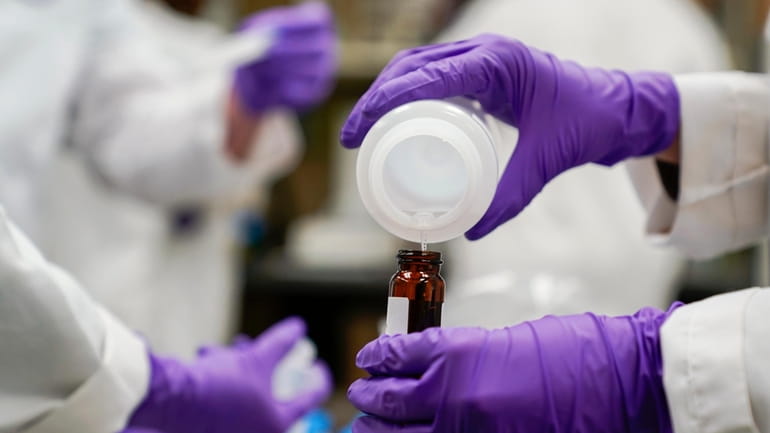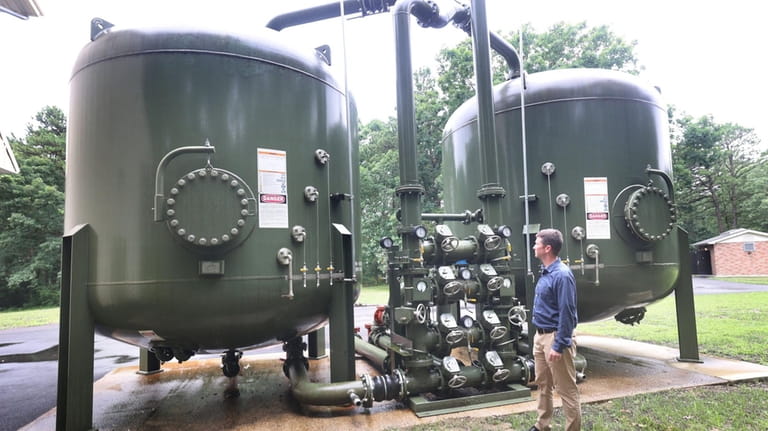New EPA limits on PFAS 'forever chemicals' set stricter standards for Long Island drinking water

This story was reported by Tom Brune, Lisa L. Colangelo, Scott Eidler, Joseph Ostapiuk, Tara Smith and Nicholas Spangler. It was written by Spangler.
The federal government will, for the first time, require utilities to limit “forever chemicals” in drinking water linked to cancers, developmental damage and other health problems, imposing stricter levels than current state standards on the contaminants in Long Island drinking water.
The move will reduce exposure for 100 million people, the Environmental Protection Agency announced Wednesday. At issue is a class of thousands of synthetic chemicals called per- and polyfluoroalkyl, or PFAS, which are found in Long Island groundwater and can be detected in the blood of almost every American. Used since the 1940s to repel oil and water and resist heat, they are commonly found in products ranging from nonstick cookware to cellphones and medical supplies. They are called “forever” chemicals because their components break down very slowly.
Exposure to PFAS has been linked to deadly cancers, impacts to the liver and heart, and immune and developmental damage to infants and children, among other health impacts, according to the EPA.
New York State in 2020 set a limit of 10 parts per trillion for PFOS and PFOA, two of the most common forever chemicals, and most Long Island water providers already have equipment in place to meet that limit. The EPA is setting maximum contaminant levels at 4 parts per trillion for each of those compounds, the lowest levels the agency said are feasible for effective implementation. That level is roughly equivalent to four grains of sand in an Olympic-sized swimming pool. For PFNA, PFHxS and a set of compounds called “GenX Chemicals,” the limit is 10 parts per trillion. Public water systems have until 2029 to comply with the limits.
WHAT TO KNOW
- The EPA on Wednesday set stringent limits on PFAS in drinking water, surpassing New York’s standards.
- With its geography and history of development, Long Island’s aquifer system is vulnerable to PFAS contamination, which has been linked to deadly cancers, impacts to the liver and heart, and immune and developmental damage.
- Water providers said they’re in compliance with EPA standards or working toward it, but treatment will be costly.
"We on Long Island have been hoping for a number of years that EPA would step up and provide leadership and regulate PFAS chemicals and drinking water," said Sarah Meyland, who serves on the state's Drinking Water Quality Council, which sets standards for contaminants including PFAS, and is a retired professor in the department of environmental technology at New York Institute of Technology. "Hopefully this will add further support to the work going on in New York to try to update our drinking water regulations and drinking water standards for these emerging contaminants that are of great concern."
Adrienne Esposito, executive director of Citizens Campaign for the Environment, called the rule "one of the most significant public health victories in a generation. ... We have genuine hope this will reduce cancer rates throughout Long Island and the nation.”
She said that up to 1 million Long Islanders could be now drinking water that meets the state limit but has levels of 2 to 10 parts per trillion of the contaminants, an estimate she said was based on data from Long Island water suppliers.
James Neri, spokesman for the Long Island Water Conference, a trade group of water suppliers, said the number of Long Islanders drinking water that does not meet the new federal standard was likely far less than 1 million. “Most suppliers that have detected this compound have taken steps to address the contamination” after 2020 that meet the federal limits, he said.
Long Island drinking water vulnerable
"New York State residents can continue to drink their water unless told otherwise by their public water system, or the local or state health department," Erin Clary, a spokeswoman for the state Department of Health, wrote in an email.
But Long Island’s geography and history make it vulnerable to PFAS, Neri said. The region is densely populated, has a history of industry and relies on a sole-source aquifer system that sits below sandy, highly permeable soil, he said. Together, those factors “created a perfect storm of issues we have in front of us,” Neri said. That has required engineering to ensure clean water.

Carbon filters that trap contaminants like PFAS, such as this one in Holbrook seen in 2022, can cost $1.5 million to $3 million per well. Credit: Newsday/John Paraskevas
As early as 2017, some of Long Island’s water suppliers began searching for solutions, many installing granular activated carbon filters to trap contaminants. Those systems work, Neri said, but are expensive to install — $1.5 million to $3 million per well — and cost, on average, more than $150,000 per year to operate. Wells with higher PFAS concentrations require filters to be changed more often. The new federal standard will likely result in “increased maintenance cycles” with higher water bills to pay for the increased upkeep, he said.
Water districts on Long Island, which have estimated a $1.5 billion cost to install treatment for recently regulated contaminants, have begun charging ratepayers for the added expenses. The Suffolk County Water Authority and Greenlawn Water District added $80-per-year surcharges in recent years. Property owners in the village of Sands Point now pay a $225 capital fee three times a year.
The EPA estimates implementation of the rule will cost $1.5 billion per year nationally, but save about that much in health care costs because it will prevent 10,000 deaths and significantly reduce illness. Nationwide implementation will create logistics issues Long Island didn’t face when New York State was one of the few mandating testing and treatment, Neri said. “It’ll be a supply chain issue that will drive lead times and drive cost,” he said.
There are other possible funding sources, though. The EPA said it's making $21 billion available for the nation's drinking water systems, including $9 billion for PFAS and emerging contaminants, through the Bipartisan Infrastructure Law.
Another possible source of funds is litigation against manufacturers of products that use PFAS. A number of Long Island towns, villages and water suppliers, including Suffolk County Water Authority, have sued in recent years. In 2023, attorneys general from 22 states, including New York, approved a $10.3 billion settlement with manufacturer 3M Co. in which the company admitted no responsibility. Suits against other manufacturers are ongoing, Neri said.
Still, some have warned of increased costs. Riverhead Water District Superintendent Frank Mancini said the promised EPA funding amounted to a "drop in the bucket" of what remediation could cost. Rep. Andrew Garbarino (R-Bayport) said in a statement he worried "about the heavy cost burden this mandate will place on states and municipalities which is sure to exceed the funding amount the Biden Administration is presenting as available."
Some experts said the new rule may not go far enough. “Even though I certainly applaud the EPA for lowering the number and creating this enforceable standard, I don't think it creates a situation where individuals can feel like there's no longer any risk," said Dr. Kenneth Spaeth, division chief of occupational and environmental medicine at New Hyde Park-based Northwell Health and Hofstra Northwell School of Medicine. "People should really still remain vigilant about what they're exposed to in regards to PFAS.”
PFAS chemicals have been detected at one of Riverhead’s public wells, near Middle Road and Northville Turnpike, said Mancini. The district is currently installing a new filtration system there and had been blending water from a nearby, unaffected well, to meet state drinking water standards.
Mancini said he worried about PFAS groundwater contamination spreading from the 6,000-acre former Grumman naval weapons plant in Calverton, where U.S. Navy jets were once built and tested. Testing in the area south of the site has shown contamination in more than 80% of wells tested, with more than half exceeding the state standard of 10 parts per trillion.
Toni Pawson, who lives in Manorville near the Grumman site, hopes the new EPA standard leads to more accountability.
“This is a game changer for us because with higher standards, [the Navy] has to test further,” Pawson, 59, said Wednesday. “It’s our right to have clean water. We didn’t put the chemicals in the water, but now we’re dealing with it.”
Kelly McClinchy, who lives in the Riverhead Town section of Manorville, has been advocating for clean water in her neighborhood for years.
She is hopeful that the more stringent requirements will lead to more widespread testing and awareness about the chemicals.
“It’s good news for anybody who drinks water,” McClinchy, 46, said.
Water providers respond
In a statement, Suffolk County Water Authority Chairman Charles Lefkowitz hailed the national standard as a “crucial step to protect public health.” SCWA, which serves 1.2 million county residents and is the largest supplier in the nation based entirely upon groundwater, meets or surpasses state standards and is “well on our way to meeting all regulatory requirements within the timework laid out by EPA.”
The authority says about a third of its 600 wells are equipped with granular activated carbon filters.
Farmingdale Village is one of the municipalities that has already started to prepare for the federal rule, said Mayor Ralph Ekstrand. The village has spent millions to filter three wells located inside its borders. Before, "we never had to filter water," Ekstrand said, noting the village had to both purchase the filtration equipment and build infrastructure to house it.
Karine Rougé, CEO of Veolia North America Municipal Water, a subsidiary of a conglomerate that operates 8,500 water and wastewater facilities and systems around the world, including wastewater for Nassau County, said the federal rule came at a pivotal time for the water industry.
“Big investment is needed,” she said. “It’s PFAS, but also pipes in the ground, some of which have got lead in them, and plants that have been built 50 years ago.”
Passage of the drinking water standard could mean that similar rules mandating treatment for PFAS in wastewater could be next as testing methods mature, she said. “There is a push for regulation” at both the state and national levels, she said.
Jaymie Meliker, a Stony Brook University public health professor, said the new limit was a qualified victory because it did not address the origins of PFAS contamination in global manufacturing.
“These companies that make the products aren’t really required to show that they don’t cause risk, or are not persistent and won’t bioaccumulate,” Meliker said. Targeting substances already in the environment means “we’re always playing catch-up.”
An industry group, the American Chemistry Council, has described PFAS as “vital to enabling our lives in the 21st century,” enabling production not just of nonstick pans but also cellphones, aircraft and medical equipment.
Given the importance of those uses, Meliker said, “we might decide, as a society, that we are OK with this potential risk.” But, he said, “we need that conversation to happen.”
Updated 17 minutes ago Two body parts suspects in court ... Teen chicken keeper ... Rangers advance ... Penn upgrades
Updated 17 minutes ago Two body parts suspects in court ... Teen chicken keeper ... Rangers advance ... Penn upgrades
